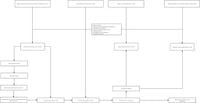Lung cancer patients frequently face a challenging complication known as malignant pleural effusion (MPE), which can significantly affect their prognosis and quality of life. In an effort to provide better prognostic tools for these patients, a recent study identified essential predictors of survival and developed a machine learning-based nomogram to tailor treatment strategies accordingly.
Conducted by researchers from the Affiliated Hospital of North Sichuan Medical College and other institutions, the retrospective analysis utilized data collected from 2013 to 2023 across various hospitals in China. They employed comprehensive statistical techniques to analyze variables associated with patient outcomes, seeking to enhance the accuracy of prognostic predictions for lung cancer patients suffering from MPE.
The study found that three clinical factors emerged as significant predictors of prognosis: treatment regimen, presence of pericardial effusion, and the total volume of pleural effusion. The nomogram created from this analysis revealed substantial survival differences among various risk groups, facilitating individualized patient evaluations.
In a statement highlighting the findings, the authors noted, "The nomogram enabled individualized risk quantification and showed significant survival differences between high-risk/very high-risk groups and low-risk/medium-risk groups." This focused approach aims to empower clinicians with a reliable tool for assessing patient outcomes in the future.
The analysis demonstrated that the logistic regression (LR) model provided the best predictive performance, achieving impressive areas under the curve (AUC) values of 0.885 for the training cohort, 0.954 for the internal testing cohort, and 0.920 for external testing cohort 1. The analyses also included independent validations with additional patient groups, confirming the effectiveness of the nomogram.
Malignant pleural effusion is primarily a result of lung cancer but can arise from other malignancies as well. The abnormal fluid buildup in the pleura can present symptoms such as dyspnea and chest pain, greatly hindering daily activity. With a median survival time of 3 to 12 months, it’s imperative to identify accurate prognostic indicators for treatment and intervention.
Current therapeutic options include various techniques, from ultrasound-guided thoracentesis to indwelling pleural catheters and chemotherapeutic approaches. However, each method carries its own risks and complications, with no consensus on the singularly most effective treatment. Therefore, clinical outcomes for patients with MPE continue to vary widely.
The study emphasized the importance of personalized treatment strategies, showing that those in low-risk categories tend to have markedly better outcomes compared to high-risk patients. In the low-risk group, comprising 60 patients, only one had a survival time shorter than a year, resulting in a mere 1.67% mortality rate. Conversely, the very high-risk group had a staggering mortality rate of 100%, with all 111 patients dying within a year.
These findings unveil critical insights into the complexity of treating patients with MPE. The LR model's predictive accuracy underscores its potential clinical utility. “The LR model demonstrated the best performance, achieving areas under the curve of 0.885 in the training cohort, 0.954 in the internal testing cohort, and 0.920 in external testing cohort 1,” the authors stated in their summary of the model's efficacy.
As the medical community continues to explore the intricacies of lung cancer treatments, predictive models like the one developed in this study offer new prospects for early intervention. The nomogram represents an essential leap toward enhancing the prognosis of lung cancer patients with MPE, reinforcing the need for personalized care in oncology.

